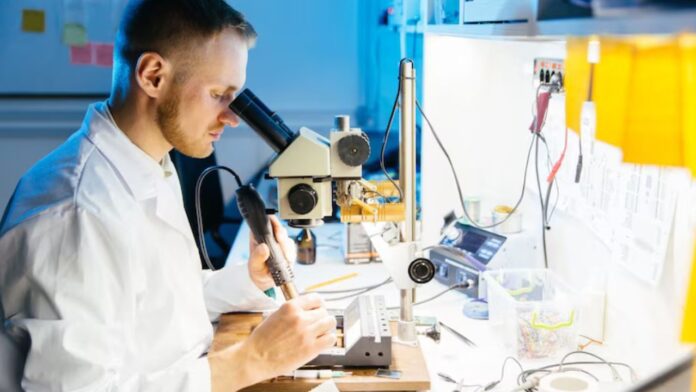Scientists in many domains have received little attention in the previous two years or more, since the world has been focused on the emergency effort to create Covid-19 vaccines and therapies. However, laboratories and researchers have continued to publish a dizzying array of big discoveries and triumphs.
1. Nuclear Fusion
According to NPR, scientists at the Lawrence Livermore National Laboratory in California claimed in December that they had generated the first fusion reaction that produced more energy than it used. The long-awaited accomplishment marked a significant step in harnessing the process that powers the sun. “This significant milestone moves us one significant step closer” to “powering our society” with zero-carbon fusion energy, said Energy Secretary Jennifer Granholm.
Fusion is achieved by rapidly colliding two nuclei of a lightweight element, such as hydrogen, and causing them to fuse. According to Einstein’s formula E = mc2, the remaining mass is turned into a massive amount of energy. Unlike fission, which involves splitting atoms, fusion uses small amounts of ordinary fuel — the amount of hydrogen in a glass of water could provide enough energy for one person’s lifetime — and produces little radioactive waste, earning it the moniker “the holy grail for the future of nuclear power.”
2. The James Webb Telescope
The James Webb Space Telescope was named the magazine Popular Science’s Innovation of the Year in Aerospace Technology. Unlike the Hubble space telescope, which scanned the skies from low Earth orbit, the Webb telescope is stationed hundreds of thousands of miles away, in Earth’s shadow, where it is permanently hidden from sunlight, according to NASA. It is kept at the optimal temperature (-370 degrees Fahrenheit) for its infrared vision, and its view is further shielded by a multi-layer sunshield.
As a result, the $10 billion JWST “can see deep into fields of forming stars,” according to Popular Science. “It can look back 13 billion years and see ancient galaxies still in their infancy.” It can peer at exoplanets, viewing them directly where scientists had to recreate weak signs of their existence previously. It can educate us about the formation of stars and galaxies from primordial stuff, which Hubble could only glimpse.”
3. Transplant Promise
In the journal Nature, a group of Yale scientists revealed that they were successful in reviving cells in the hearts, livers, kidneys, and brains of pigs that had been dead in a lab for an hour. The researchers accomplished this feat by pumping a custom-made solution named OrganEx into the pigs’ bodies using a device similar to a heart-lung machine. The pigs’ hearts began to beat, sending the solution through their veins.
The pigs were not awakened, but their organs began to operate again, and they “never got stiff like a typical dead pig,” according to The New York Times. According to the Times, the researchers hope that their breakthrough would eventually assist boost the quantity of human organs available for donation by allowing doctors to extract viable organs from bodies long after death. The technology could also help to protect hearts from heart attacks and brains from strokes.
4. A Universal Flu Vaccine
Every year, fighting the flu provides a new challenge because influenza viruses are continually mutating. However, Scott Hensley of the University of Pennsylvania and his colleagues have developed a flu vaccine based on mRNA molecules — the same technology that Moderna, Pfizer, and BioNTech used to develop their COVID-19 vaccines. According to New Scientist, the vaccination induced antibody responses against all 20 known strains of influenza A and B in mouse tests, with effectiveness lasting four months. The results in ferret experiments were comparable, raising hopes that the universal vaccination could also work in humans.
5. Changing an Asteroid’s Trajectory
Relax if you’ve seen “Armageddon,” “Deep Impact,” or any other movie depicting an asteroid threatening to wipe out life on Earth. NASA’s Double Asteroid Redirection Test (DART) mission demonstrated that it is capable of deflecting a massive space rock from hitting with our planet. NASA sent the 1,100-pound DART spacecraft hurtling into Dimorphos, a 525-foot-diameter asteroid, at 14,000 miles per hour to see if the impact force would be enough to affect the spacecraft’s trajectory.
Dimorphos, which did not pose a threat to Earth, was orbiting Didymos, its larger parent asteroid, every 11 hours and 55 minutes before the collision. DART collided with Dimorphos on September 26 and its orbit time was 11 hours and 23 minutes, 32 minutes shorter than before, indicating a major alteration in its route. “We are all responsible for protecting our home planet.” “After all, it’s the only one we’ve got,” NASA Administrator Bill Nelson said. “This mission demonstrates NASA’s efforts to be prepared for whatever the universe throws at us.”
6. AI for Artists
Artificial intelligence is expanding the possibilities for businesses and families, and new text-to-image generators are providing artists, urban planners, and reconstructive surgeons with a new tool to help them envision ideas, according to Venture Beat. According to Popular Science, DALL-E 2, which was launched by Open AI in July, examines hundreds of millions of captioned photographs to convert text prompts given by users into images.
According to Mark Chen, the primary researcher on DALL-E 2, image generators like DALL-E 2 aim to “democratize” art. “This is the most exciting new technology in the AI space since natural-language translation,” remarked Atlantic deputy editor Ross Anderson.
7. New Vaccines to Fight Malaria
Malaria, which is widespread in over 90 countries, kills an estimated 627,000 people each year. Vaccines could help decrease or eliminate the toll, but researchers have yet to create a highly effective one. According to a study published in December in “npj Vaccines,” an open-access scientific journal in the Nature Portfolio, the technology used to create mRNA vaccines against COVID-19 assisted a research team led by George Washington University in developing two experimental mRNA vaccine candidates that are highly effective in reducing malaria infection and transmission.
“Malaria elimination will not happen overnight, but such vaccines could potentially banish malaria from many parts of the world,” according to Nirbhay Kumar, a professor of global health at the George Washington University Milken Institute School of Public Health.
8. Cancer Treatments Advance
Scientists have announced advances in the fight against cancer on multiple fronts. According to the Institute for Cancer Research, a team led by Chris Jones, a professor of pediatric brain tumor biology at the Institute of Cancer Research, collaborated with the company BenevolentAI to develop a new drug combination to fight diffuse intrinsic pontine glioma, an incurable childhood brain cancer. The recommended combination increased mouse survival by up to 14% and has been tested in a small group of children.
Dr. Luis A. Diaz Jr. of Memorial Sloan Kettering Cancer Center described a treatment that resulted in complete remission in all 18 rectal cancer patients who took the medicine in an article published in the New England Journal of Medicine in June. “I believe this is the first time this has happened in the history of cancer,” said Dr. Diaz to The New York Times.
Read More: The Greatest Scientific Feuds That Changed the World
9. Injecting Human Cells Into Rats’ Brains to Study Psychiatric Disorders
According to a study published in the journal Nature, Stanford University scientists successfully injected human nerve cells into the brains of newborn lab rats and discovered that they developed connections with the animals’ own brain cells, controlling their behavior. Human cells ended up constituting one-sixth of the brains of the rats. The cluster, known as a brain organoid, then develops in ways similar to those seen in human brains, which could help researchers learn more about schizophrenia, autism spectrum disorder, bipolar disorder, and other neuropsychiatric illnesses. “It’s definitely a step forward,” said Paola Arlotta, a well-known Harvard University brain organoid researcher who was not involved in the work.
According to BestLife, several bioethicists are concerned about the ramifications of implanting human cells into rats. “It raises the possibility that you’re creating an enhanced rat that might have cognitive capacities greater than an ordinary rat,” said Julian Savulescu, a bioethicist at the National University of Singapore. However, Dr. Sergiu Pasca, a Stanford professor of psychiatry and behavioral sciences who pioneered the transplant process, claims that the human brain organoids, which are generated from stem cells, stop developing after a few months. “No matter how long we keep them in a dish, they still do not become as complex as human neurons would be in an actual human brain,” Pasca added.
10. Creating Life Without Sperm or Eggs
Researchers at Israel’s Weizmann Institute of Science generated mouse embryos within a bioreactor using stem cells cultivated in a Petri dish — no egg, no sperm. The embryos matured normally, with elongation beginning on day three and a beating heart developing by day eight. It was the first time scientists were able to create entirely synthetic mouse embryos outside of the womb.
The discovery was a watershed moment in the study of how stem cells generate different organs and how mutations cause developmental disorders. “It also raises profound questions about whether other animals, including humans, might one day be cultured from stem cells in a lab,” STAT News reports. “As soon as the science starts to move into a place where it’s feasible to go from a stem cell population in a Petri dish all the way through to organ development — which suggests one day it will be possible to go all the way to creating a living organism — it’s a pretty wild and remarkable time,” said Paul Tesar, a developmental biologist at Case Western Reserve University School of Medicine who was not involved in the study.
11. Curing HIV
A 53-year-old man became the fifth person to be cured of HIV after receiving a stem cell transplant shortly after being diagnosed. According to The Washington Post, the “Dusseldorf patient,” who was also diagnosed with a severe form of blood cancer, underwent a bone marrow transplant 10 years ago that provided him with HIV-resistant stem cells. He has been HIV-free for four years and has no sign of the virus in his body.
“It’s really [a] cure, and not just, you know, long-term remission,” said Dr. Bjorn-Erik Ole Jensen, according to ABC News. Stem cell transplants are considered high-risk and are often reserved for cancer patients. The patient from Dusseldorf was only the third to undergo the treatment and be cured of HIV. For the time being, the treatment will most likely be reserved for cancer patients, according to the Post, but it “shows that it’s not impossible — just very difficult — to remove HIV from the body.”
12. Carbon Capture
Scientists have discovered a method to capture atmospheric CO2 and convert it to baking soda, which can then be stored in the sea. Researchers discovered a way to make carbon capture more efficient by combining current approaches in a recent study published in the journal Science Advances. “This simple ability to capture CO2 in a high quantity, in a small volume of material, is a unique aspect of our work,” said the study’s principal author, Arup SenGupta, according to the BBC.
Baking soda is also suitable for ocean storage. “Higher alkalinity also means more biological activity; that means more CO2 sequestration,” SenGupta explained. In response, the ocean can operate as a “infinite sink” with a “immense capacity for accessible CO2 storage lasting hundreds to thousands of years,” according to Stuart Haszeldine of the University of Edinburgh.
However, in order to be truly effective, carbon capture must be scaled up, which will only happen if “it’s made a licensing condition of continuing to sell fossil fuels,” according to Myles Allen of the University of Oxford.
13. Mice With Two Male Parents
Researchers were succeeded in producing living baby mice from two male dads. According to ABC News, this was accomplished by altering the chromosomes of a male stem cell, which transformed it into a female egg cell. “This is the first case of making robust mammalian oocytes from male cells,” said Katsuhiko Hayashi of Kyushu University, who led the study, according to The Guardian.
While the great majority of the mice pups died, the ones who did survived grew up properly and became reproductive adults. The genetic tinkering necessary to make the embryos is “a significant advance with significant potential applications,” says Keith Latham, a developmental scientist at Michigan State University. It has the potential to be used to treat or prevent genetic abnormalities, as well as to assist same-sex couples in having biological children.
14. Slowing Alzheimer’s
According to the BBC, a medicine developed by Eli Lilly appears to be reducing the progression of Alzheimer’s disease by roughly one-third. Donanemab works as an antibody to attack and eliminate “sticky gunk” called beta-amyloid, which “builds up in the spaces between brain cells, forming distinctive plaques that are one of the hallmarks of Alzheimer’s,” according to the BBC. “We are now entering a period of disease modification, where we might realistically hope to treat and maintain someone with Alzheimer’s disease with long-term disease management rather than palliative and supportive care,” said Dr. Cath Mummery of the National Hospital for Neurology and Neurosurgery in the United Kingdom.
However, there is a risk of deadly brain enlargement, which could afflict three of the clinical study participants.
15. AI Mind Reading
According to a research published in the journal Nature, scientists have developed an AI-based decoder that can convert a person’s brain activity into text. The device is non-invasive, meaning no surgical implants are required, and it employs the same AI technology as the chatbot ChatGPT. The device detected brain activity and determined the words a person was hearing.
“We don’t like to use the term mind reading,” researcher Alexander Huth told CNN. “We think it conjures up things that we’re not actually capable of.” According to him, the “real potential application of this is in helping people who are unable to communicate.” To soothe any fears that the technology could represent a threat to privacy as it advances, Jerry Tang, the paper’s principal author, stated that everyone’s brain data should be kept private. “Our brains are one of the last frontiers of privacy.”
Also Read: The Next Big Threat to Humanity: 15 Dangerous Technology
16. Improving Heart Health
According to a study published in the New England Journal of Medicine, bempedoic acid, a daily pill, has demonstrated its capacity to reduce the risk of heart disease, particularly in those who have adverse reactions to statins. Statins are commonly given to lower cholesterol; however, many people cannot or do not want to take them due to negative effects. “Statins are known to cause muscle aches in a subset of people,” USA Today reports.
Bempedoic acid works in the same way as statins, but because it is exclusively activated in the liver, it is less prone to induce muscle pain. One of the side effects is an increased risk of gout.
17. Gene Therapy for Muscular Dystrophy
According to NPR, the Food and Drug Administration has approved gene therapy for children with Duchenne muscular dystrophy. The medication is only available to children aged four and five while more study into its safety and effectiveness is conducted.
Muscular dystrophy affects boys significantly more than girls and can be debilitating, if not deadly, in one’s 30s or 40s. Sarepta Therapeutics’ medication has received significant criticism, with some questioning whether it is actually safe and effective.
18. Discovering the Motion of Space-Time
Scientists discovered evidence that gravitational waves distort the fabric of space and time. “What we measure is the Earth kind of moving in this sea,” astrophysicist Michael Lam explained to The Washington Post. “It’s bobbing around — and not just up and down, but in all directions.” The findings confirm a feature of Einstein’s Theory of Relativity in which “space is not serenely empty, and time does not march smoothly forward,” according to the Washington Post.
The “low-pitch hum of gravitational waves resounding throughout the universe,” as discovered by astronomers, was published in The Astrophysical Journal Letters. According to The Wall Street Journal, while the nature of the hum is unknown, astronomers assume it arose from supermassive black holes circling each other. “Before now, we didn’t even know if supermassive black holes merged, and now we have evidence that hundreds of thousands of them are merging,” said Chiara Mingarelli, a Yale University astrophysicist and member of the North American Nanohertz Observatory for Gravitational Waves (NANOGrav), which led the research.
The discovery of gravitational waves “does not put any torque on everyday human existence,” according to the Post, “but it does offer potential insight into the physical reality we all inhabit.”
19. Sequencing the Y-Chromosome
Scientists have completed the sequencing of the full Y chromosome, one of the human sex chromosomes found in those born male. According to the research paper published in the journal Nature, the feat has been “notoriously difficult” due to the “complex repeat structure” of the Y chromosome.
“Just a few years ago, half of the human Y chromosome was missing” from our understanding of the human genome, according to Monika Cechova, co-lead author on the paper. “I would credit new sequencing technologies and computational methods for this,” said Arang Rhie, a co-author on the article. In 2020, the X chromosome was entirely sequenced.
Understanding the Y chromosome can aid with a variety of health concerns, including fertility. Genes have also “been shown to be required for the prevention of cancer and cardiovascular disease,” according to Kenneth Walsh, a biochemistry and molecular genetics professor at the University of Virginia School of Medicine.




























